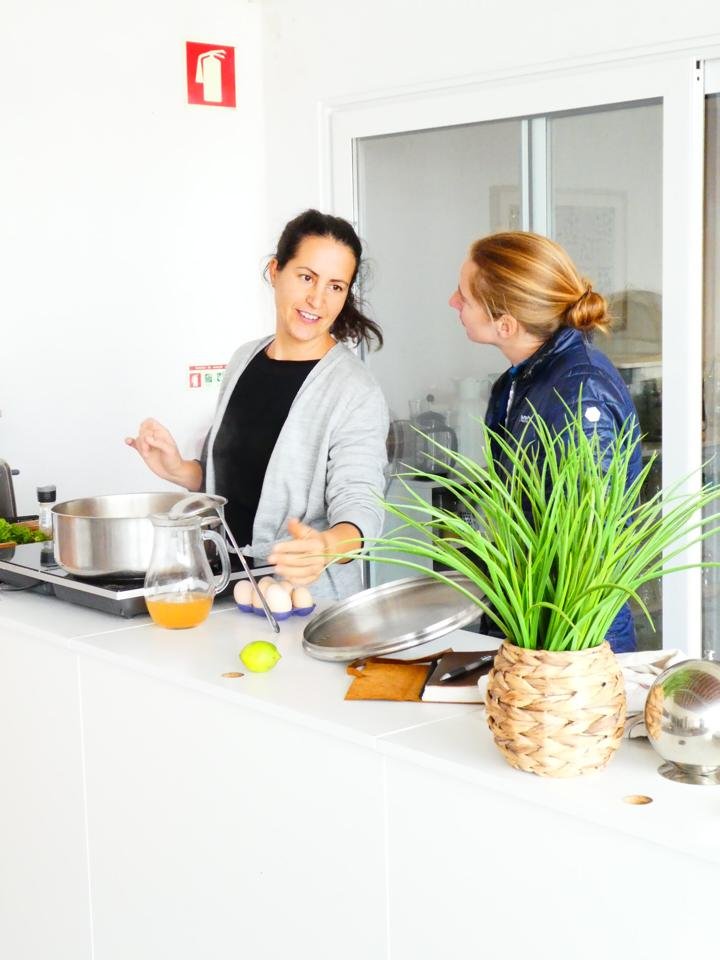Caldeirada de vegetais de horta: the easiest Portuguese stew
When I asked Ana if we could cook together and she agreed, I was elated, if a little nervous. I got the feeling that, for both of us, the kitchen is a sanctuary, a place to hide in surrounded by steam, music, aroma.
Ana in the outside kitchen
What followed was a discussion on which was the best dish to showcase both Portuguese food and the beautiful organic produce on the farm. There was some concern here, as I’ve often found when cooking around the world, that the foreigner wants heritage on a plate.
Ana is used to teaching dishes, hosting cookery courses at Humus Farm and being a student at a local Portuguese course on vegetarian cooking. Whilst she cooks meat for the family and guests, lunches on the farm were adapted for Ana and myself, preferring the chew of kale to beef.
Cooking for lunch gives us about an hour to prepare something for the 7 or 8 people who work on the farm. Interns, housekeepers, WWOOFERS, family all sit together. With 4 children, all teenagers, evening meals are, understandably, spent at home.
All this to say that the panic abated fairly swiftly. We were on the same page. Let’s find something that has Portuguese roots, feeds a crowd, won’t take hours to prepare, and has veggies galore (for both nutritional value and glut management!)
Caldeirada wins. A dish prepared with layers of produce. It is constructed in a large pot unstirred, cooking in its own broth. Ana checks I’m happy that we prepare it in a less traditional way, without fish. Fine by me, I say. In fact, even better.
A very serious chicken
We head to the orchard to collect what we need. I’m on the hunt for peppers and parsley, Ana for black turnip and eggs from the chickens.
Ana tells me it’s the first time that black turnip has been grown at Humus Farm. I’ve come to know it well whilst bottling copious amounts of preserved kale and toscana. It’s taken well to the soft sandy soil. When peeled, the smooth white flesh makes a severe contrast to its otherwordly skin. You can see estuaries, martian homelands, snake skin in its weathered black coat.
Black turnip close up, half peeled
Back in the kitchen, we get to slicing. Ana checks my approach, makes some changes. The onions are cut into rounds to take up more space at the bottom of the pan, giving more distance from the heat. Turnips and potatoes the same thickness. Ana’s happy, so I am too.
This is a game of layers. Culinary jenga.
The prepared veg
Ana reminds me of the story of caldeirada, which Bruno had told when we had first enjoyed the more traditional version, cooked with cod (bacalhau).
This is usually a fish stew. Prepared on fishing boats this simple stew began its life at sea. Using the fresh catch, a mix of oily and non-oily fish and seafood are layered with potatoes, tomatoes, peppers, onions.
The seasoning? Sea water of course.
I love the image of a hungry fisherman leaning over the side of his boat, the seagulls and gannets thick in the air and sea, bringing ladles of briney seawater onboard for the crew’s lunch. The reality, I’m sure, is much less romantic.
Ready for the lid
The lid is placed on our veggie version. The dogs stir, feeling somehow something might be happening. They shadow Ana everywhere. We leave the caldeirada to cook and she heads to the office. Her entourage stretches and trails after.
Half an hour, the potatoes are tender, Ana reappears from the office. She cracks eggs into dimples she makes in the top of the stew. Their orange yellow yolks nestled in the steaming veg.
The others we have lunch with lurk closer and closer. The table is laid, a bottle of wine found, the dogs shooed out.
We have the caldeirada with a green lentil salad, sharp with balsamic vinegar and mustard leaves from the garden.
Plates are filled once, and then again. With Ana’s guidance, we’ve found a sweet spot where the plentiful Portuguese sea meets the ample Portuguese land.
A plate of caldeirada. I now really wish I’d split that yolk…
Recipe
Think of these as a ratio guidance, and adjust for however many you’re cooking for. We were cooking for 7.
6 white onions (sliced into rings)
6 red peppers, sliced
6 medium potatoes, sliced into rounds
4 turnips, sliced into rounds
200ml white wine
3tsp chilli flakes
3tsp smoked paprika
3 bay leaves
Water
Parsley - one small bunch
Coriander - one small bunch
7 eggs
Olive oil
Salt and pepper
Method
Grab your biggest pot.
This is a game of layers, each layer of vegetable needs a sprinkle of salt, cracked black pepper, paprika and chilli. Your layers are:
onions, turnip, peppers, potato, bay leaves, onions, turnip, peppers, potatoes.
When you’ve finished your layers, pour over the wine, a confident glug of olive oil, and half fill your pot with water.
Cover, bring to the boil, and then leave to simmer. Don’t stir it! If you want to, give the pot a little shake back and forth, but no more than that.
When the potatoes are almost cooked through, make little wells for your eggs and crack them in. Pop the top back on to let them poach, which will only take a couple of minutes.
Finish the dish with some freshly chopped parsley and coriander.
We served this with a green lentil salad on the side, replete with mustard leaves from the garden.








